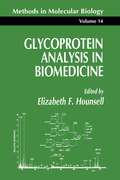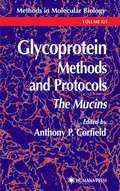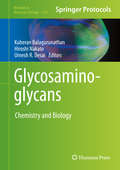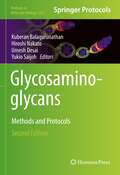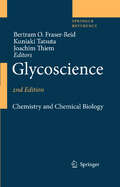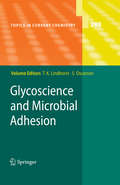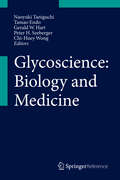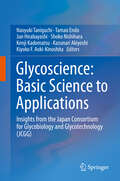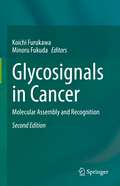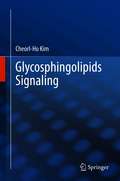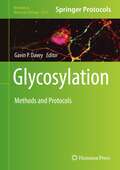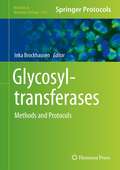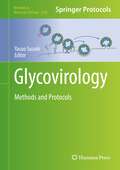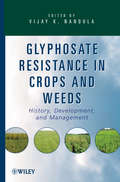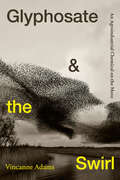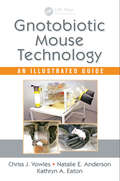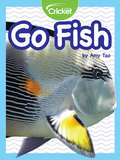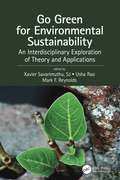- Table View
- List View
Glycoprotein Analysis in Biomedicine
by Elizabeth F. HounsellGlycoprotein Analysis in Biomedicine brings together a comprehensive range of protocols related to carbohydrate biochemistry. The first half of the manual outlines physiochemical (MS and NMR), chemical, and chromatographic techniques for defining the structures and diversity of oligosaccharide sequences. The second half describes more biological and immunological approaches used to detect changes in glycosylation patterns in disease.
Glycoprotein Methods and Protocols
by Anthony P. CorfieldAnthony P. Corfield and a group of hands-on expermentalists bring together in Glycoprotein Methods and Protocols: The Mucins a state-of-the-art collection of reliable and tested methods for the study of all aspects of mucins. These powerful methods range from the preparation of mucins to their detection and quantitation with molecular biological and biochemical reagents. Also included are methods for the assessment of mucin peptide and carbohydrate, of mucin biosynthesis and degradation, and of mucin bacteriology and cell biology. Glycoprotein Methods and Protocols: The Mucins offers today's researchers a complete range of readily reproducible analytical techniques for the analysis of mucins.
Glycosaminoglycans
by Kuberan Balagurunathan Hiroshi Nakato Umesh R. DesaiGlycosaminoglycans: Chemistry and Biology emphasizes several areas of glycosaminoglycan research especially analysis and application of GAGs using a variety of approaches. Chapters focus on chemical and enzymatic synthesis of GAGs for therapeutic purposes; biophysical and biochemical methods for studying GAG-protein interactions; molecular approaches for modulating and defining GAG biosynthesis; informatics approaches for deciphering GAG code; computational approaches for establishing specific and/or non-specific interactions and genetic and biochemical tools for manipulating/visualizing glycosaminoglycan expression and studying their functions in a variety of model organisms. Written in the highly successful Methods in Molecular Biology series format, chapters include introductions to their respective topics, lists of the necessary materials and reagents, step-by-step, readily reproducible laboratory protocols and key tips on troubleshooting and avoiding known pitfalls. Authoritative and practical, Glycosaminoglycans: Chemistry and Biology serves as a valuable manual for cutting edge methodologies and practical tips to overcome any obstacles with experimentation pertaining to chemistry and biology of glycosaminoglycans.
Glycosaminoglycans: Methods and Protocols (Methods in Molecular Biology #2303)
by Kuberan Balagurunathan Hiroshi Nakato Umesh Desai Yukio SaijohThis second edition volume expands on the previous edition with new information on the structural analysis of glycosaminoglycans (GAGs); chemical and enzymatic synthesis of GAGs; biophysical, biochemical, and computational analysis of GAG-protein interactions; molecular and genetic approaches to manipulating GAG cell biology; and molecular and genetic methods involving animal models and organoids. This volume also offers insight and guidance to non-glycoscience researchers who are performing advanced experiments on GAGs. Written in the highly successful Methods in Molecular Biology series format, chapters include introductions to their respective topics, lists of the necessary materials and reagents, step-by-step, readily reproducible laboratory protocols, and tips on troubleshooting and avoiding known pitfalls. \Cutting-edge and authoritative, Glycosaminoglycans: Methods and Protocols, Second Edition is a valuable experimental manual for practicing researchers including graduate and post-doctoral fellows, and provides them with the latest methodologies and practical tips to overcoming barriers in understanding the chemistry and biology of GAGs.
Glycoscience
by Shin-Ichiro Nishimura Sabine Flitsch Bertram O. Fraser-Reid Biao Yu Joachim Thiem Kuniaki Tatsuta Yukishige Ito Hirosato Kondo Gregory L. CotéAs a reflection of the quantum leap that has been made in the study of glycostructures, the first edition of this book has been completely revised and updated. The editors give up-to-date information on glycostructures, their chemistry and chemical biology in the form of a completely comprehensive survey. Glycostructures play highly diverse and crucial roles in a myriad of organisms and important systems in biology, physiology, medicine, bioengineering and technology. Only in recent years have the tools been developed to partly understand the highly complex functions and the chemistry behind them. While many facts remain undiscovered, this MRW has been contributed to by a large number of the world's leading researchers in the field.
Glycoscience and Microbial Adhesion
by Stefan Oscarson Thisbe K. LindhorstMumtaz Virji: Ins and Outs of Microbial Adhesion. - Martina Lahmann: Architectures of multivalent glycomimetics for probing carbohydrate-lectin interactions. - Stefan D. Knight and Julie Bouckaert: Structure, Function, and Assembly of Type 1 Fimbriae. - Knut Ohlsen, Tobias A. Oelschlaeger, Jörg Hacker, A. Salam Khan: Carbohydrate receptors of bacterial adhesins: Implications and reflections. - Susann Teneberg: The multiple carbohydrate binding specificities of Helicobacter pylori. - Andrea Kristina Horst and Christoph Wagener: Bitter sweetness of complexity. - Dietrich Mack, Angharad P. Davies, Llinos G. Harris, Johannes K. M. Knobloch and Holger Rohde: Staphylococcus epidermidis biofilms: functional molecules, relation to virulence, and vaccine potential. -
Glycoscience: Biology and Medicine
by Naoyuki Taniguchi Peter H. Seeberger Tamao Endo Gerald W. Hart Chi-Huey WongThe aim of the book is to provide a succinct overview of the current status of glycoscience from both basic biological and medical points of view and to propose future directions, in order to facilitate further integrations of glycoscience with other fields in biological and medical studies. Glycans (carbohydrate oligomers) are the so-called building blocks of carbohydrates, nucleic acids, proteins and lipids and play major roles in many biological phenomena as well as in various pathophysiological processes. However, this area of glycoscience has been neglected from the research community because glycan structures are very complex and functionally diverse and as compared to proteins and nucleic acids simple tools for the amplification, sequencing and auto-synthesis of glycans are not available. Many scientists in other fields of research have now realized that glycosylation, i. e. the addition of glycans to a protein backbone, is the most abundant post translational modification reactions and is an important field of research and sometimes they require a glycobiology and/or glycochemistry approach to be used. It is still difficult, however, for non-expert researchers to use these techniques. This book provides numerous but simple overviews of current topics and protocols for the experiments. The book is aimed at university students and above, including non-experts in the field of glycoscience. "
Glycoscience: Insights from the Japan Consortium for Glycobiology and Glycotechnology (JCGG)
by Naoyuki Taniguchi Jun Hirabayashi Tamao Endo Kiyoko F. Aoki-Kinoshita Shoko Nishihara Kenji Kadomatsu Kazunari AkiyoshiThis book presents the state of the art in glycoscience and proposes a road map for the coming decade, focusing on the potential of glycoscience research to shed light on important basic science issues and give rise to exciting new applications, especially in the field of diagnosis and therapeutics. Individual sections offer in-depth coverage of various topics relating to glycans and biopharmaceuticals, glycans in medical science and medicine, glycan technologies, glycans in food and nutrients, and glycan-related materials and their uses. In addition, the book presents an exemplary training course on glycomics and highlights educational and analytical web resources, and also includes glossaries and boxes summarizing key facts to ensure ease of understanding for non-expert readers and students. Written by more than 150 active participants in the Japan Consortium for Glycobiology and Glycotechnology (JCGG), whose goal is to promote the development of interdisciplinary glycoscience and establish a global network in the field, it is a valuable resource for students, postdocs, and researchers in the life sciences as well as for stakeholders and professionals in government, funding agencies and industry.
Glycosignals in Cancer: Molecular Assembly and Recognition
by Koichi Furukawa Minoru FukudaThis book, now in an extensively revised second edition, provides a comprehensive summary of the latest knowledge regarding glycosignals and a thorough analysis of their involvement in not only cancers but also other refractory conditions such as chronic inflammatory disorders. Many relevant topics are covered, including the search for novel tumor epitopes related to carbohydrates, the assembly of glycoconjugates, the modulation of signaling pathways by glycosylation, and interactions between complex carbohydrates and their recognition molecules. The role of various research approaches, for example advanced mass spectrometry, high-resolution imaging, and bioinformatics, is closely examined, and the results of novel therapeutic trials targeting glycosignals are discussed. The book will be essential reading for students and young researchers with an interest in glycoscience. In presenting new results and approaches and identifying areas for future research, it will also be of benefit for specialists in the field.
Glycosphingolipids Signaling
by Cheorl-Ho KimThis book presents the latest knowledge and the most recent research results on glycosphingolipid (GSL)-mediated signaling. GSLs are important constituents of the plasma membrane that exert their distinct functions through binding to certain functional proteins. They play a role in various human diseases and also function as human alloantigens. Cellular GSLs are associated with many biological functions such as cellular oncotransformation, phenotype change, neuronal or embryonic development, regulation of cell division, cell–cell interaction, cell attachment, adhesion, and motility, and intracellular signaling via protein–carbohydrate or carbohydrate–carbohydrate interactions. This book opens by providing the key background on GSL glycan–receptor interactions and mammalian GSL synthesis. Up-to-date information is then presented on all aspects of GSL-dependent signaling. Viral protein and bacterial toxin protein interactions with host cell GSLs are examined in depth, and the concluding chapter is devoted to signaling regulation. The book should assist in the further development of new strategies against emerging infectious agents and intractable diseases.
Glycosylation Engineering of Biopharmaceuticals
by Alain BeckGlyco-engineering is being developed as a method to control the composition of carbohydrates and to enhance the pharmacological properties of monoclonal antibodies (mAbs) and other proteins. In Glycosylation Engineering of Biopharmaceuticals: Methods and Protocols, experts in the field provide readers with production and characterization protocols of glycoproteins and glyco-engineered biopharmaceuticals with a focus on mAbs. The volume is divided in four complementary parts dealing with glyco-engineering of therapeutic proteins, glycoanalytics, glycoprotein complexes characterization, and PK/PD assays for therapeutic antibodies. Written in the highly successful Methods in Molecular BiologyTM series format, chapters include introductions to their respective topics, lists of the necessary materials and reagents, step-by-step, readily reproducible laboratory protocols, and tips on troubleshooting and avoiding known pitfalls. Authoritative and cutting-edge, Glycosylation Engineering of Biopharmaceuticals: Methods and Protocols serves as an ideal guide for scientists striving to push forward the exciting field of engineered biopharmaceuticals.
Glycosylation: Methods and Protocols (Methods in Molecular Biology #2370)
by Gavin P. DaveyThis volume explores the latest techniques and methods used for performing up-to-date glycosylation research. The chapters in this book are organized into four parts. Part One looks at the latest analytical and bioinformatics technologies that enable the characterization of glycosylation complexity. Part Two details the importance of synthetic chemistry and glycoengineering in the fields of bioprocessing and biotherapeutic development. Part Three discusses systems biology and computational technologies used by scientists to analyze glycosylation events in the cell. Part Four focuses on how cellular glycosylation biomarkers can be identified and used to characterize human clinical datasets. Written in the highly successful Methods in Molecular Biology series format, chapters include introductions to their respective topics, lists of the necessary materials and reagents, step-by-step, readily reproducible laboratory protocols, and tips on troubleshooting and avoiding known pitfalls. Cutting-edge and practical, Glycosylation: Methods and Protocols is a valuable resource for any scientist or researcher interested in learning more about this exciting and developing field.
Glycosyltransferases: Methods and Protocols
by Inka BrockhausenGlycosyltransferases (GTs) are essential for the biosynthesis of complex glycoconjugates and are powerful tools to study the functions of complex glycans in health, development and disease. Complex glycoconjugates, such as glycoproteins, proteoglycans and glycolipids, are assembled by GTs which synthesize specific linkages between sugars or sugars and protein. This is in contrast to the non-specific or less specific chemical glycation reactions, transglycosylation and reverse glycosylation reactions. Glycosyltransferases: Methods and Protocols contains a wide range of studies, methods and protocols which form a solid basis for investigations of the role and mechanisms, biology and pathology involving GTs. Written in the successful Methods in Molecular BiologyTM series format, chapters include introductions to their respective topics, lists of the necessary materials and reagents, step-by-step, readily reproducible protocols, and notes on troubleshooting and avoiding known pitfalls. Authoritative and easily accessible, Glycosyltransferases: Methods and Protocols is a vital contribution to glycobiology and glycopathology, and to applications of these enzymes in biotechnology and drug development. It will prove invaluable to students, postdoctoral fellows, and senior scientists carrying on research of GTs that has been intensified over the last years.
Glycovirology: Methods and Protocols (Methods in Molecular Biology #2556)
by Yasuo SuzukiThis volume details applications in molecular biological techniques and focuses on applications to determine the involvement of glycans in virus interactions. Chapters guide readers through glycan analysis, glycan distribution analysis, glycan and lectin microarray, preparation of recombinant viral domain protein, reverse genetics and receptor binding, virus-host interactions and receptor binding, and sialidase: assays and inhibitors. Written in the successful Methods in Molecular Biology series format, chapters include introductions to their respective topics, lists of the necessary materials and reagents, step-by-step, readily reproducible protocols, and notes on troubleshooting and avoiding known pitfalls. Authoritative and cutting-edge, Glycovirology: Methods and Protocols aims to be an essential resource for researchers who wish to learn more about glycovirology.
Glyphosate Resistance in Crops and Weeds
by Vijay K. NandulaNew technologies are becoming available for managing glyphosate resistant (GR) weeds and reducing their spread. GR crop technology has revolutionized crop production in the developed world and the benefits are gradually spilling over to the developing world. In order to sustain an effective, environmentally safe herbicide such as glyphosate and the GR crop technology well in to the future, it is imperative that the issue of GR weeds be comprehensively understood. This book provides such an essential, up-to-date source of information on glyphosate resistance for researchers, extension workers, land managers, government personnel, and other decision makers. Provides comprehensive coverage of the intensely studied topic of glyphosate resistant (GR) in crops Details the development of glyphosate resistance and how to detect and manage the problem in crops Helps standardize global approaches to glyphosate resistance Encompasses interdisciplinary approaches in chemistry, weed science, biochemistry, plant physiology, plant biotechnology, genetics, ecology Includes a chapter on economic analysis of GR impact on crops
Glyphosate and the Swirl: An Agroindustrial Chemical on the Move (Critical Global Health: Evidence, Efficacy, Ethnography)
by Vincanne AdamsIn Glyphosate and the Swirl Vincanne Adams explores the chemical glyphosate—the active ingredient in Roundup and a pervasive agricultural herbicide—as a predicament of contested science and chemically saturated life. Adams traces the history of glyphosate’s invention and its multiple uses as activists, regulators, scientists, clinicians, consumers, and sick people try to determine its safety and harm. Scientific and political debates over glyphosate’s toxicity are agitated into a swirl—a condition in which certainty is continually contested, divided, and multiplied. This movement replicates the chemical’s movement in soils, foods, bodies, archives, labs, and legislative bodies, settling in some places here and in other places there, its potencies changing and altering what it touches with different scales and kinds of impact. The swirl is both an artifact of academic capitalism, activist tactics, and contested scientific facts and a way to capture the complexity of contemporary life with chemicals.
Glück gehabt! Zwölf Gründe, warum es uns überhaupt gibt
by Olaf FritscheEigentlich dürfte es uns gar nicht geben …Die Wahrscheinlichkeit, dass ein Universum mit einem Sonnensystem entsteht, zu dem ein steiniger Planet gehört, der seinen Stern im richtigen Abstand umkreist, damit Wasser weder gefriert noch sofort verdunstet, und dass sich dort auf wundersame Weise kohlenstoffbasierte Moleküle zu einem selbstreproduzierenden System organisieren, das wir als „Leben“ bezeichnen, und über Jahrmilliarden hinweg allen von außen kommenden und selbst produzierten Gefahren trotzt, bis schließlich eine einzige Sorte aufrecht gehender, warmblütiger Hominiden beginnt, sich Gedanken über die Wahrscheinlichkeit ihres Daseins zu machen … also, diese Wahrscheinlichkeit ist so verschwindend und über alle Maßen gering, dass ein Außenstehender eigentlich mit einem lässigen Achselzucken gefahrlos behaupten dürfte, dass so etwas sicherlich niemals geschehen wird. Und trotzdem sind wir da.… Wir haben eben unverschämtes Glück gehabt. Gleich zwölfmal.Olaf Fritsche, Biologe, Wissenschaftsjournalist und Buchautor, zeichnet in diesem Buch die unglaubliche Geschichte unserer Existenz nach. Entstanden ist ein zutiefst unterhaltsamer Rückblick auf den langen Weg vom Urknall bis zum modernen Menschen._____Es hätte so leicht schiefgehen können.Ob wir daran denken, wie anders das Universum aussehen würde, wenn einige Naturkonstanten nur leicht abweichende Werte angenommen hätten, oder welche Rolle die Säugetiere heutzutage spielen würden, wenn die Dinosaurier nicht ausgestorben wären – immer wieder in der Geschichte des Universums, der Erde und der Evolution gab es Gabelungen, an denen die Entwicklung durchaus hätte falsch abbiegen können. Ein einziger Fehler hätte gereicht, und die Erde hätte ohne den Menschen auskommen müssen.Das Buch Glück gehabt! Zwölf Gründe, warum es uns überhaupt gibt stellt ein Dutzend solcher entscheidender Wendepunkte auf dem Weg vom Urknall zum Menschen vor. Es liefert dem Leser auf unterhaltsame Weise Einblicke in die physikalischen, chemischen, geologischen und biologischen Prozesse an diesen Umschlagpunkten, stellt ihm die wichtigsten Forscher vor und nimmt ihn mit zu ihren Entdeckungen. Dabei ist es so leicht verständlich geschrieben, dass es sich als Bettlektüre eignet, enthält aber zugleich alle notwendigen Informationen, um den Leser auf den aktuellen Stand des Wissens zu heben.Glück gehabt! Zwölf Gründe, warum es uns überhaupt gibt ist ein Buch für all jene, die es nicht verlernt haben, zu staunen und sich zu wundern, warum die Welt ausgerechnet so ist, wie sie ist. Nun: Wir haben eben unwahrscheinlich viel Glück gehabt!
Gnotobiotic Mouse Technology: An Illustrated Guide
by Chriss J. Vowles Natalie E. Anderson Kathryn A. EatonThe popularity of germ-free animal models, particularly mice, for investigation of human physiology and disease has recently exploded. Gnotobiotic Mouse Technology: An Illustrated Guide provides the first manual for the maintenance, husbandry, and experimental manipulation of germ-free and gnotobiotic mice. It includes information on all aspects of
Gnu's World
by Richard D. EstesThis is the first scholarly book on the antelope that dominates the savanna ecosystems of eastern and southern Africa. It presents a synthesis of research conducted over a span of fifty years, mainly on the wildebeest in the Ngorongoro and Serengeti ecosystems, where eighty percent of the world's wildebeest population lives. Wildebeest and other grazing mammals drive the ecology and evolution of the savanna ecosystem. Richard D. Estes describes this process and also details the wildebeest's life history, focusing on its social organization and unique reproductive system, which are adapted to the animal's epic annual migrations. He also examines conservation issues that affect wildebeest, including range-wide population declines.
Go Fish
by Amy TaoWhat makes all these animals fish? Fish live in the water, but they have other defining characteristics as well. Who else lives in the ocean?
Go Green for Environmental Sustainability: An Interdisciplinary Exploration of Theory and Applications
by Sj Xavier Savarimuthu Usha Rao Mark F. ReynoldsThis book highlights topics ranging from green chemistry and engineering to bioremediation, smart technologies, and sustainable business practices. The common threads running through this volume are the need for urgent action, a vision for a sustainable future, and the awareness that solutions must be widely accessible and advance the welfare of all nations, especially in the face of climate change. The authors delineate how we can protect and restore natural ecosystem potential to achieve environmental sustainability. They provide a clear idea of today’s environmental challenges and solutions, focus on energy use patterns and the reduction of energy consumption, advocate for increased environmental awareness, and discuss environmental monitoring systems. The book contains many domestic and international case studies and showcases visionary ideas in action to illustrate sustainability principles. This volume provides an in-depth reference for stakeholders from academia, government, and industry on the latest research in environmental sustainability solutions. Inspired by the common wisdom that we do not inherit this Earth from our ancestors but instead borrow it from our children, the authors offer solutions to emergent problems. This research comprises an important contribution to the global effort to build a more sustainable tomorrow.
Go Organic, Level 6
by Saddleback Educational Publishing StaffThemes: Hi-Lo, nonfiction, full-color, differentiated instruction. Teach environmental studies and global warming in the inclusive classroom with these unique informational books. Available in two reading levels with identical front covers, so striving readers do not feel "singled out," each title methodically explains the tough problems faced by our planet plus solutions large and small. Features include: Reading level 3 books are Fountas-Pinnell level O, P, and Q; reading level 6 books are Fountas-Pinnell level W. Scientific terms are defined in context. Identical dramatic four-color covers (back cover band identifies books that are lower level). Teacher's Guides with reproducible activities allow students to work from either text. Glossary defines difficult terms. "Did You Know?" sections contain interesting facts. End-of-book "Facts & Figures" section summarizes critical information. The index takes students directly to topics of interest.
Go Play: A Ya Paranormal Urban Fantasy Thriller (The Last Lodge on Earth #2)
by Kailin Gow Kira G.Schitt's Creek Meets Stranger Things AND the Walking Dead... I moved with my mother from Hollywood, California to a small town in Texas. I thought my life was over, but... It was the move that would save our lives when the world suddenly turned crazy! **The Last Lodge on Earth Series s a YA Fantasy Action Adventure with a nod to Chronicles of Narnia, Harry Potter, and the Walking Dead and is appropriate for age 14 and up!
Go Wild! Lions (Go Wild!)
by Margie MarkarianPlay, pounce, hunt, and ROAR with lions in this lively introduction to these powerful big cats! Learn all about lions, including their awesome body parts, how they hunt, and what life is like in a pride. Little kids will go wild over photos of adorable lion cubs and more as they explore: Where lions live What their families are like How lion babies grow up Other amazing wild cats How lions communicate And moreYoung readers will also find out why lions need our help and what people around the world are doing to protect them. Filled with fun facts, awesome photos, games, and activities that will inspire kids to care about these amazing animals. Complete your collection with: Go Wild! Pandas Go Wild! Sea Turtles Go Wild! Elephants Go Wild! Lemurs
Go Wild! Pandas
by Margie MarkarianWelcome to the wild world of pandas! In this intro to the species, youngsters discover where on Earth this bear lives, what it eats, how big it grows, and how it communicates. Cool photos of adorable panda cubs and panda relatives bring the creatures into full focus. After learning the basics, young readers will discover why pandas need our help and what people around the world are doing to help save them. Filled with fun facts, games, and an activity focused on making a difference in the panda's world, Go Wild! will inspire kids to care about this adorable animal.
